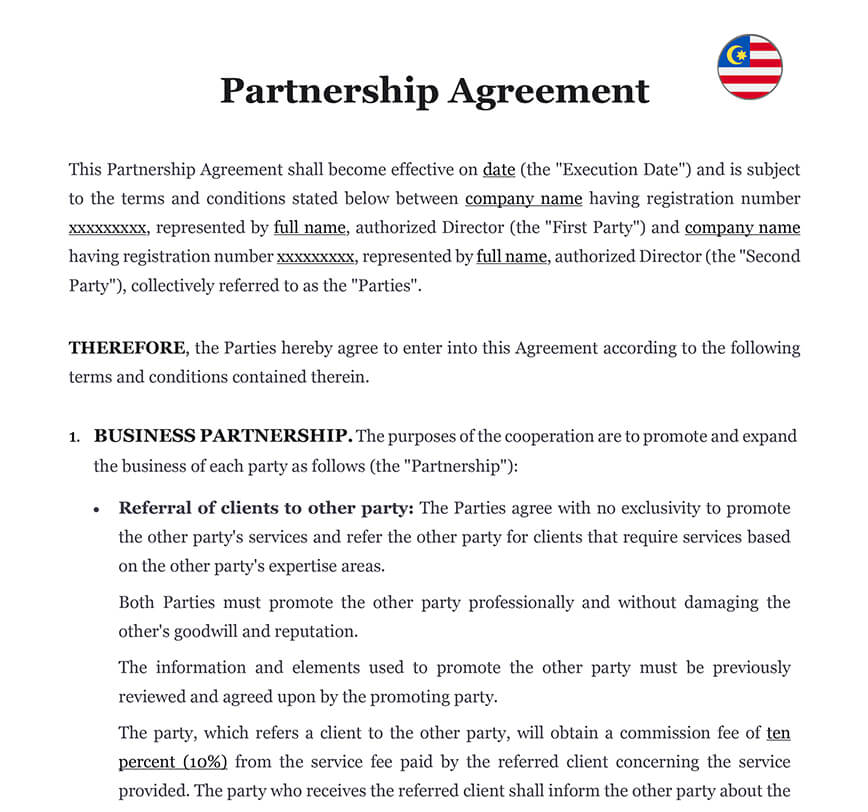All of these requirements must be met before a partnership may be formed.
A partnership agreement is reasonably simple to draught and is suited for partnerships with two to ten participants. However, the agreement may also be used for bigger collaborations.
If you offer an incentive to become a partner, you may be able to attract new employees. The proportions of ownership of partnership assets and revenue and costs do not have to be equal. Your share ratio might be 50:50, 60:40, 70:30, or any other combination. This contract can be used if one or more of the partners is “sleeping” or “silent” i.e. donates funds, experience, or assets but does not participate in the day-to-day operations of the firm.
While most partnership agreements involve human partners, this agreement can be used when one or more parties is a firm or even a non-profit organisation. As partners, your ‘business’ might be a single specialized project, such as a technological development project, and it does not have to be commercial in nature.
In India, the following laws govern various elements of Partnership Agreements:
There is no requirement to register a partnership deed in India. A Partnership Agreement is not legally required for the formation of a partnership. If you do not complete an agreement, your partnership will be governed by the default norms of state partnership law. Default rules are laws that apply solely if a partnership agreement contains no conflicting clauses. State partnership laws also include required restrictions that apply regardless of the agreement’s wording.
In India, the Partnership Agreement must be printed on Non-Judicial Stamp Paper having a value of Rs.100/- or higher. This sort of agreement is often signed in the presence of all partners, and each partner keeps a signed original for his or her records. Here are some significant conditions that must be included in your Partnership Agreement:
When creating a partnership, if there is no provision for the partnership’s termination, we refer to it as a partnership at will. According to Section 7 of the Indian Partnership Act 1932, for a partnership to be a partnership at will, two requirements must be met. • There is no agreement for a definite period for the existence of a partnership. • There is no provision regarding the determination of a partnership.
So, if the partners agree on the duration or the determination of the business, this will not be a partnership at will. However, if a partnership was formed for a defined duration and continues to function after that term has expired, it will become a partnership at will.
The partners may now agree on the term of this arrangement during the formation of a partnership. This would imply that the partnership was formed for a specific period of time.
As a result, such a relationship will not be at will, but rather for a set period of time. The collaboration will cease after the specified time period expires.
However, there may be instances where the partners continue to do business after the period has expired.They continue to split earnings, and there is some mutual agency. In that instance, the partnership will become a partnership at will.
A partnership might be formed to carry on ongoing business or to carry out a single initiative or activity. A particular partnership is created when a partnership is formed just to carry out one commercial endeavor or finish one activity.
The partnership will be dissolved after the initiative or activity is completed. The partners can, however, reach an agreement to continue the collaboration. In the absence of this, the collaboration stops after the assignment is completed.
When the goal of the partnership’s establishment is to do business, it is referred to a general partnership.
Unlike a specific partnership, the scope of the business to be carried out is not determined in a general partnership. As a result, all partners will be held accountable for the partnership’s conduct.
Although dissolving your partnership is not as straightforward as suspending business and closing down shop, it also does not have to be extremely hard.
When a partnership dissolves, the individuals involved are no longer legally partners, but the partnership continues until the business’s debts are settled, its legal existence is terminated, and the remaining assets of the company are distributed.
1. Review Your Partnership Contract: If you and/or your partner(s) decide to leave the relationship, you must check the legal agreement to verify you follow the dissolution process provided in the contract. The agreement usually includes a need for a majority vote to dissolve the firm.
2. Discuss the Decision to Dissolve with Your Partner(s): You founded your company with your partner(s), and you should have an open discussion with them about dissolving it. You and your partner must consider your commitments, such as the company’s debts and future liabilities, as well as how you want to wind down the company.
3. File a Dissolution Form: To legally declare the end of the partnership, you must file a dissolution of partnership form with the state in where your firm is located. This clearly states that you are no longer a partner or accountable for the partnership’s debts; it is a smart precaution to take.
4. Notify Others: Inform other parties of the dissolution, including workers, customers, the landlord, and any government bodies, such as the IRS, that have registered or provided a license to your firm.
5. Close and settle all accounts: Notify your creditors of the dissolution as well. You should make certain that all of your debts are paid. Close all commercial bank accounts. Following that, divide all assets in accordance with the partnership agreement or any other arrangement you have with your partners. Seek legal counsel from a business attorney if there is insufficient cash to satisfy the partnership’s obligations and responsibilities.




